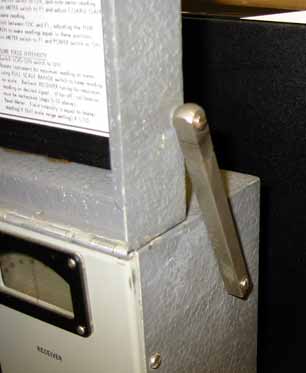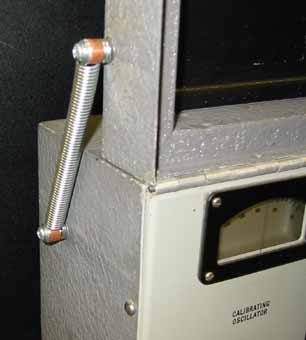
 |
|
|||||||||
|
|
|||||||||
 |
Field
Intensity Meter Repair |
April 2003 |
|
If
you have a Nems-Clarke 120 or RCA
WX-2 AM Field Intensity Meter, it may have a missing or
broken cover spring. The meter uses
two such springs to hold the front cover/antenna over the face of the meter or
upright on top of the meter when it is in use.
The spring assemblies are very nicely machined items with internal
springs. They are no longer
available because the meters have not been manufactured for many years.
The meters are not reliable when one spring is missing.
The springs are needed to provide necessary tension to keep the front
cover/antenna in proper position when someone is trying to make a field
intensity measurement. The
cover has three electrical contacts that must make before the meter will work.
Two of the contacts are for the antenna and the third one turns on the
battery power when the cover is opened. Those
contacts need to be cleaned on occasion to maintain performance.
In
my case, the missing spring created a dilemma that needed a solution.
After some thought, a trip to a good local hardware store and $1.25 in
change resulted in the purchase of a 3/8 inch OD expansion spring that is
normally used to close a screen door on a home.
Back
at the shop, I bent the last two turns, of the spring, over at a 90 degree
angle. Then I cut the spring to length and bent over the last two
turns at the other end. After some
experimentation and some more bending, I came up with a spring that provided
tension when the meter cover is open or closed and yet does not have too much
tension to keep the cover from moving between the two extremes.
To keep the spring in place over the threaded spacers in the meter and cover, I
hack sawed two 3/8" OD copper tubing lengths to about a ½ inch length each.
Then, a flat washer, lock washer, and 6-32 x 3/8 machine screw, were
installed on each spacer. Careful
trimming of the copper tubing, on a bench grinder, resulted in the tubing
providing just the right pressure to keep the spring straight so it would not
rub on the meter cabinet when the cover is opened and closed. |
 |
 The new spring and spacers in place of the original. |
|
As with anything, and especially when working with calibrated equipment, I make "before and after measurements" to make sure any change does not disrupt the calibration.
It
is a gratifying experience for me to do this kind of repair and look at it with
pride for a job well done at little cost. If
both sides of the meter had one of these new springs, possibly you would not
know it wasn't made that way at the factory.
The
original leather handles, on these meters, are failing too.
You can have a local shoemaker fabricate a new handle at little cost.
Batteries are not a serious problem either.
Any supply house that caters to antique restorers will have, or can get,
the 67.5 volt Model 467 batteries. In
the Midwest, I get batteries at a place called Batteries Plus.
Their business is supplying batteries for everything from hearing
aids to trucks.
Before
you do any serious measuring with one of these meters, I recommend you go to an
area free of power lines and compare a field intensity reading with one taken in
the same spot with a Potomac Instruments FIM-21 or FIM-41 that has been recently
calibrated. Do not run both meters
simultaneously as the calibrating oscillator in one meter can look like a signal
to the other meter. Mark Persons, W0MH, is certified by the Society of Broadcast Engineers as a Professional Broadcast Engineer with more than 30 years experience. He has written numerous articles for Radio World over the years. His Web site is www.mwpersons.com From the Radio Guide April, 2003 issue
http://www.radio-guide.com
|
|
Questions? Email Mark Persons: teki@mwpersons.com |
|
.